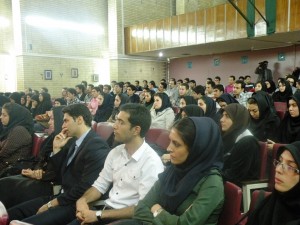What may be the world’s first combined performance of freehand calligraphy and extemporary music and song took place at Tabriz University recently, before a large and attentive audience. While Vahid demonstrated the Kufic script with the Arabic phrase,اِنّه مِن سلیمان و اِنٌه بسم الله الرٌحمنِ الرٌحیم (This message is from Solomon and it is Bisme Allah), Javad Asefi played the setar as he sang poems by Hafez and Rumi. This innovative approach will surely attract many more people to take an interest in the art of calligraphy.
Before the demonstration and music began, Vahid was interviewed by two lecturers. He emphasized the charm, beauty, and simplicity of the Kufic script in comparison with other styles, and added that today’s reassessment of the script could encourage its decorative use (on the walls of our living spaces, for example), as well as inspiring contemporary script designs. He said that the Kufic script should not only be researched for its own sake but should be mined as a source of new letter forms and alphabets.
“Today,” said Vahid, “we need to bring Kufic script from ancient manuscripts and stone inscriptions into contemporary typography and graphics, and this can be achieved through professional teaching. I am keen to motivate the participants of this meeting to take up the study of Kufic,” he continued, “and I hope to be able to meet some of the needs of contemporary graphic designers and typeface designers. We really must modify our contemporary fonts: they are not attractive or appropriate to our eyes, which is why people are less inclined to study books and newspapers”.
He explained that one of the difficulties of Kufic is that in some manuscripts it is written without dots or vowels. Nonetheless, insisted this artist and researcher, we must teach Kufic and develop the script for contemporary use.
View Gallery ~ View the Videos

